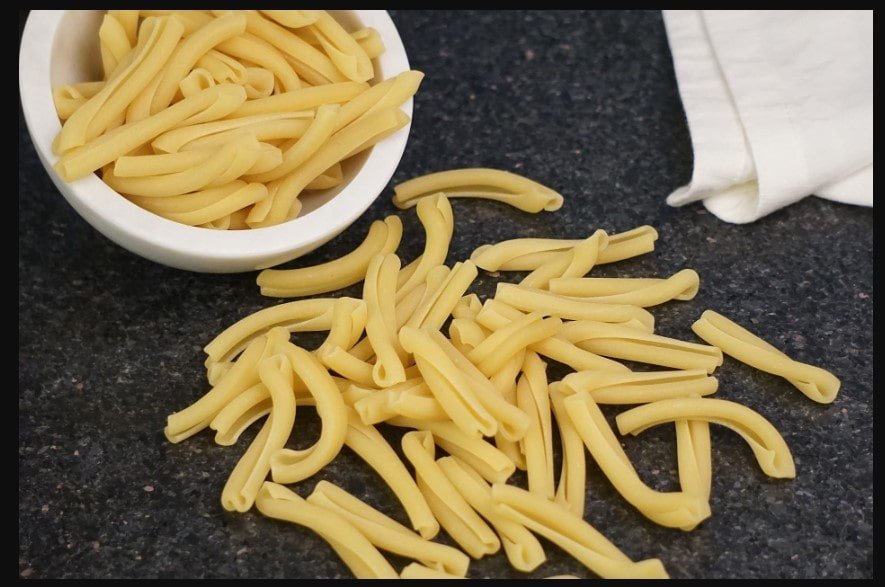Introduction to Casarecce
In the ever-evolving world of pasta, where shapes and sauces define the dining experience, casarecce has emerged as a trending topic, captivating food enthusiasts around the globe.
Originally hailing from Sicily, this pasta’s unique twisted shape and versatility have made it a favourite in traditional Italian cuisine and modern culinary creations.
This article delves into the origins, culinary applications, and reasons behind the rising popularity of casarecce, offering insights into why it has become a must-try pasta shape for any gourmet lover.
Origins and History
Casarecce, which translates to “homemade,” is a pasta shape that carries a deep connection to the culinary traditions of Southern Italy, particularly Sicily. Its name reflects the simple, rustic roots of the pasta, initially crafted by hand at home. The pasta’s design—short, twisted tubes with open edges—was intended to mimic ancient rolled scrolls and was historically made by wrapping small rectangles of dough around thin wooden rods. This shape allowed it to capture and hold onto sauces, making every bite flavorful and satisfying.
While Sicily is credited as the birthplace of casarecce, its popularity has spread across Italy and beyond, with variations found in other Southern regions like Calabria and Campania. Pasta is now a common ingredient in various regional dishes, each showcasing local flavours and ingredients (fedetheclumsychef.com) (The Pasta Project).
Culinary Uses and Pairings
One of the reasons casarecce has gained widespread acclaim is its versatility. The pasta’s ability to hold sauces makes it an ideal choice for various dishes, from simple weeknight meals to elaborate gourmet presentations. Traditionally, casarecce is paired with classic Sicilian sauces that highlight the flavours of the Mediterranean. For example, Pesto alla Trapanese, a Sicilian variation of pesto made with almonds, tomatoes, and basil, is a popular companion for casarecce. Another beloved pairing is with eggplant-based sauces, such as Pasta alla Norma, which combines fried eggplant, tomatoes, and ricotta salata (The Pasta Project) (foodie kitchen).
Beyond traditional recipes, casarecce has found its way into contemporary kitchens, where chefs experiment with new ingredients and flavours. It is often used in dishes featuring rich, creamy sauces, spicy sausage ragùs, or even lighter, vegetable-based preparations. The pasta’s shape is particularly effective at trapping bits of meat, vegetables, and cheese, ensuring each mouthful blends textures and tastes (Cooking My Dreams) (fedetheclumsychef.com).
Why Casarecce is Trending
Several factors contribute to the growing popularity of casarecce. Firstly, there has been a resurgence of interest in traditional Italian cooking, with many home cooks and chefs seeking to explore regional specialities. Casarecce, with its strong ties to Sicilian cuisine, offers an authentic taste of Italy that appeals to those looking to expand their pasta repertoire beyond the usual spaghetti or penne.
Additionally, casarecce’s versatility makes it suitable for various dietary preferences. It can be used in gluten-free recipes, with vegan sauces, or in protein-rich dishes featuring seafood or meats. This adaptability has made it a go-to pasta for those with diverse dietary needs (fedetheclumsychef.com) (Recipe Self).
The pasta’s unique shape also contributes to its visual appeal, making it a favourite for food photography on social media platforms like Instagram. Dishes featuring casarecce are often beautifully presented, with the pasta’s twisted form adding an artistic element to the plate. This aesthetic appeal and culinary versatility have helped Casarecce gain traction among food bloggers and influencers (Recipe Self).
Cooking Tips and Variations
To fully appreciate casarecce, it’s essential to cook it properly. As with most pasta, it should be cooked al dente to maintain its firm texture, which pairs perfectly with rich, hearty sauces. It’s recommended to reserve a bit of the pasta cooking water to help emulsify and thicken the sauce, ensuring it clings to every twist and turn of the pasta (foodie kitchen).
For those looking to experiment, casarecce can be used in various recipes. Try pairing it with roasted vegetables and a simple olive oil dressing for a light, summery dish, or incorporate it into baked pasta casseroles where its shape will hold up well under the broiler.
Whether sticking to traditional Sicilian recipes or venturing into new culinary territory, casarecce is a pasta shape that invites creativity and experimentation in the kitchen (Cooking My Dreams) (Recipe Self).
Conclusion
Casarecce has made its mark as a beloved pasta shape in both traditional and modern cuisine. Its origins in Sicily give it a rich culinary heritage, while its versatility allows it to adapt to various dishes and dietary preferences.
As it continues to gain popularity, casarecce will likely become a staple in kitchens worldwide, offering a delicious and visually appealing alternative to more familiar pasta shapes.
Whether you’re a seasoned pasta fan or new to Italian cooking, casarecce is a must-try that promises to bring a taste of Sicily to your table.

